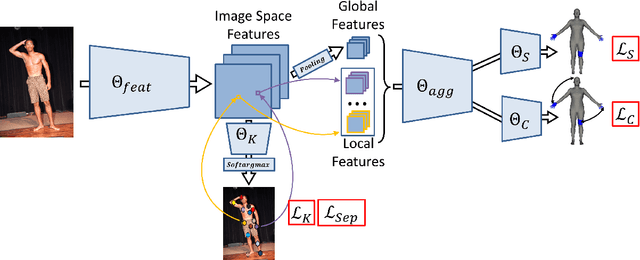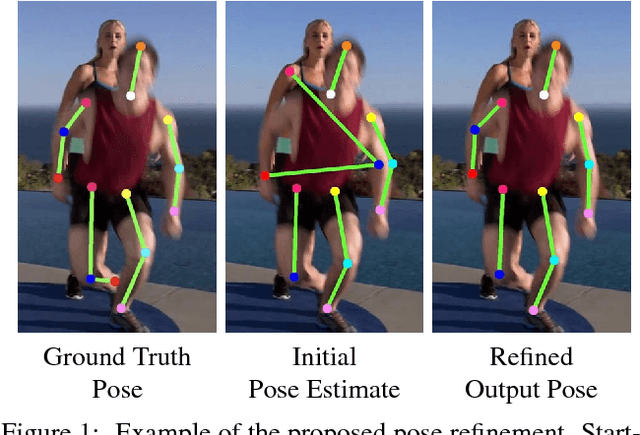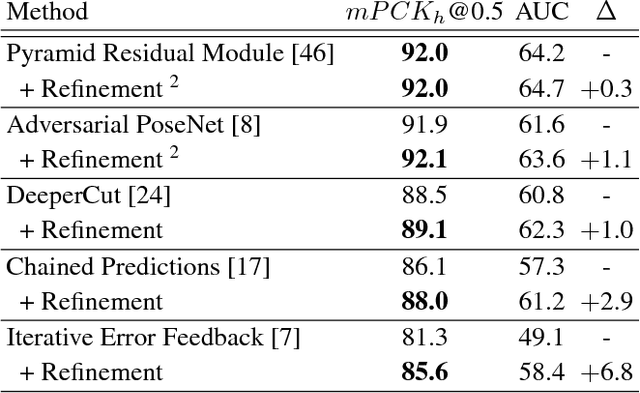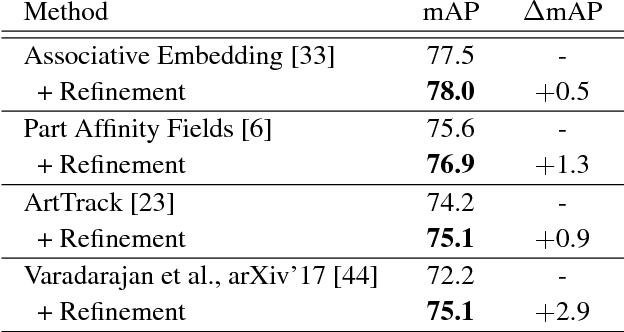Mihai Fieraru
Reconstructing Three-Dimensional Models of Interacting Humans
Aug 04, 2023Abstract:Understanding 3d human interactions is fundamental for fine-grained scene analysis and behavioural modeling. However, most of the existing models predict incorrect, lifeless 3d estimates, that miss the subtle human contact aspects--the essence of the event--and are of little use for detailed behavioral understanding. This paper addresses such issues with several contributions: (1) we introduce models for interaction signature estimation (ISP) encompassing contact detection, segmentation, and 3d contact signature prediction; (2) we show how such components can be leveraged to ensure contact consistency during 3d reconstruction; (3) we construct several large datasets for learning and evaluating 3d contact prediction and reconstruction methods; specifically, we introduce CHI3D, a lab-based accurate 3d motion capture dataset with 631 sequences containing $2,525$ contact events, $728,664$ ground truth 3d poses, as well as FlickrCI3D, a dataset of $11,216$ images, with $14,081$ processed pairs of people, and $81,233$ facet-level surface correspondences. Finally, (4) we propose methodology for recovering the ground-truth pose and shape of interacting people in a controlled setup and (5) annotate all 3d interaction motions in CHI3D with textual descriptions. Motion data in multiple formats (GHUM and SMPLX parameters, Human3.6m 3d joints) is made available for research purposes at \url{https://ci3d.imar.ro}, together with an evaluation server and a public benchmark.
DreamHuman: Animatable 3D Avatars from Text
Jun 15, 2023



Abstract:We present DreamHuman, a method to generate realistic animatable 3D human avatar models solely from textual descriptions. Recent text-to-3D methods have made considerable strides in generation, but are still lacking in important aspects. Control and often spatial resolution remain limited, existing methods produce fixed rather than animated 3D human models, and anthropometric consistency for complex structures like people remains a challenge. DreamHuman connects large text-to-image synthesis models, neural radiance fields, and statistical human body models in a novel modeling and optimization framework. This makes it possible to generate dynamic 3D human avatars with high-quality textures and learned, instance-specific, surface deformations. We demonstrate that our method is capable to generate a wide variety of animatable, realistic 3D human models from text. Our 3D models have diverse appearance, clothing, skin tones and body shapes, and significantly outperform both generic text-to-3D approaches and previous text-based 3D avatar generators in visual fidelity. For more results and animations please check our website at https://dream-human.github.io.
Learning Complex 3D Human Self-Contact
Dec 18, 2020



Abstract:Monocular estimation of three dimensional human self-contact is fundamental for detailed scene analysis including body language understanding and behaviour modeling. Existing 3d reconstruction methods do not focus on body regions in self-contact and consequently recover configurations that are either far from each other or self-intersecting, when they should just touch. This leads to perceptually incorrect estimates and limits impact in those very fine-grained analysis domains where detailed 3d models are expected to play an important role. To address such challenges we detect self-contact and design 3d losses to explicitly enforce it. Specifically, we develop a model for Self-Contact Prediction (SCP), that estimates the body surface signature of self-contact, leveraging the localization of self-contact in the image, during both training and inference. We collect two large datasets to support learning and evaluation: (1) HumanSC3D, an accurate 3d motion capture repository containing $1,032$ sequences with $5,058$ contact events and $1,246,487$ ground truth 3d poses synchronized with images collected from multiple views, and (2) FlickrSC3D, a repository of $3,969$ images, containing $25,297$ surface-to-surface correspondences with annotated image spatial support. We also illustrate how more expressive 3d reconstructions can be recovered under self-contact signature constraints and present monocular detection of face-touch as one of the multiple applications made possible by more accurate self-contact models.
Learning to Refine Human Pose Estimation
Apr 21, 2018



Abstract:Multi-person pose estimation in images and videos is an important yet challenging task with many applications. Despite the large improvements in human pose estimation enabled by the development of convolutional neural networks, there still exist a lot of difficult cases where even the state-of-the-art models fail to correctly localize all body joints. This motivates the need for an additional refinement step that addresses these challenging cases and can be easily applied on top of any existing method. In this work, we introduce a pose refinement network (PoseRefiner) which takes as input both the image and a given pose estimate and learns to directly predict a refined pose by jointly reasoning about the input-output space. In order for the network to learn to refine incorrect body joint predictions, we employ a novel data augmentation scheme for training, where we model "hard" human pose cases. We evaluate our approach on four popular large-scale pose estimation benchmarks such as MPII Single- and Multi-Person Pose Estimation, PoseTrack Pose Estimation, and PoseTrack Pose Tracking, and report systematic improvement over the state of the art.
 Add to Chrome
Add to Chrome Add to Firefox
Add to Firefox Add to Edge
Add to Edge